Steel radiators - types and features
Today the building materials market offers a large selection of various types of radiators. At the same time, many experienced people refuse new-fashioned models and prefer high-quality and proven steel products. In this article we will look at what steel radiators are and what are their features.

Features of steel batteries
Merits
Metal radiators have many advantages, such as:
- High performance - The heat transfer coefficient of these products is significantly higher than that of analogues made of cast iron. Because of this, they cope well with the heating of both small and large premises.
- Easy operation and care - from the owner of these heating devices it is required only to periodically wipe them with a rag from dust. No other battery maintenance is required.
- Attractive appearance - thanks to this, heating devices can be a profitable addition to the interior.
- Possibility to choose products depending on the power of heating equipment, features of the system and a number of other factors.
- The price is much lower than aluminum and bimetallic analogues.
- Strength - steel batteries can be successfully used in centralized heating systems, while they are able to withstand even strong water hammer.
- High heating rate.
Tip! When purchasing steel radiators, you must also buy a special set for installation. Its presence will significantly simplify and speed up their installation.
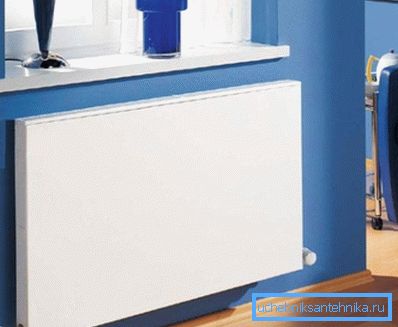
disadvantages
The disadvantages of these devices are few, but they are available:
- Not suitable for use in open heating systems.
- Poor tolerated drain coolant.
- Incompatibility with some types of plastic pipes. Therefore, when buying a product, you must immediately find out to which pipes it can be connected. This information contains instructions.
For these reasons, these heaters are more often used in private homes than in apartments.
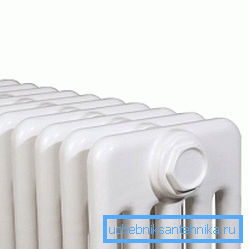
Types and device
Most models of steel radiators are made of cold-rolled steel, about 1.5 mm thick. Due to this, the products have high durability and also retain their performance qualities for a long time.
Structurally, all existing batteries of steel can be divided into the following types:
| Steel Sectional Heating Battery | A distinctive feature of these products is increased strength, so that they can work with increased pressure. Externally, the products resemble traditional cast iron batteries, however, are more durable and efficient. They are composed of several sections by spot welding. It should be noted that the cost of these heaters is the highest. |
| Tubular radiator | The product is produced in the form of a system of tubes, which are combined into a single design. Steel tubular radiators are designed to work under pressure - 10-15 atmospheres, therefore, are an excellent solution for autonomous and centralized systems. It should be noted that these batteries have a catchy and original design. |
| Panel batteries | Recently, these radiators are particularly popular. They are presented in a wide price and style range. Therefore, you can choose the right option for any home. Among the distinctive features of panel radiators are the following points:
However, it should be noted that the maximum pressure for which these devices are designed is 6-10 atmospheres. Therefore, they are not suitable for use in centralized heating systems. The design of panel batteries consists of two sheets of steel with stamping, which are welded together using modern welding technologies. In addition, U-shaped ribs are provided in the panels, which increase the efficiency of these devices. |
Note! The choice of the type of steel appliance heating depends on many factors, among which the cost plays an important role. However, first of all it is necessary to take into account the working pressure in the system, the temperature of the liquid, as well as the interior design.
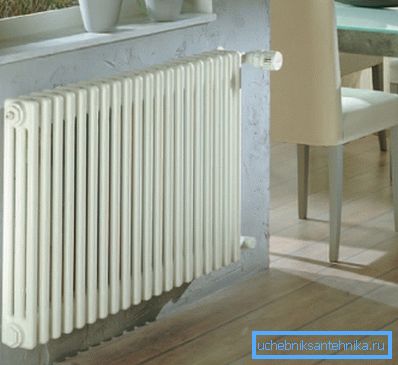
In addition, steel radiators differ in the method of connection, they can be:
| With lateral connection | Connection can be made from the left or right side. In this case, the supply pipe is connected from above, and the return pipe is connected to the lower branch pipe. This scheme ensures effective circulation of the coolant inside the heating device. It is better to use the side connection with a radiator length of up to 1.6 m, and also if the length is four times the height. |
| Bottom connection | This connection is usually used when using powerful equipment in the system, while ensuring high quality of heat transfer. The steel radiator with bottom connections can be equipped with a thermostat, which allows you to adjust the heating temperature. |
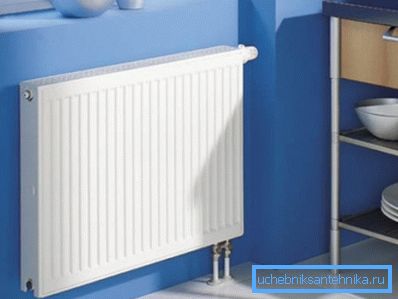
Selection of steel radiators
Having decided on the type of device, it remains only to choose a product. Today, products from different manufacturers, both foreign and domestic, are on the market, but how to choose the best quality radiators?
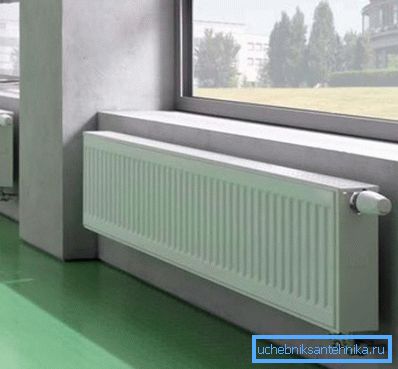
Of course, determining the quality of the eye is not easy, especially for an inexperienced person. Therefore, in order to avoid any unpleasant "surprises" in the course of operation, products from trusted manufacturers should be preferred.
For example, we can recommend:
- Panel batteries - Kermi (Germany), Lidea (Russia); Thermoplus (Italy).
- Tubular type - Demrad (Turkey), Korado (Czech Republic), Purmo (Finland).
- Sectional - Rondra (Italy), Cordivari (Italy), Loza (Ukraine).
In addition, the purchase of heating devices should be in large hardware stores. In this case, you can be sure that the seller complies with the warranty.

That's all the main features and types of steel radiators.
Conclusion
Steel heating radiators are an excellent choice for most heating systems. In addition to low cost, they attract good heat dissipation and durability, which is especially important for heating devices.
From the video in this article, you can pick up some additional information on this topic.